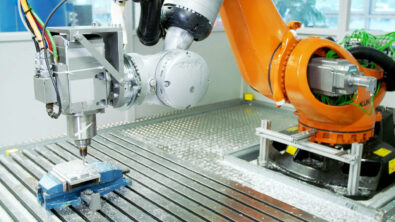The executive’s guide to digital manufacturing for heavy equipment – eBook

The future of manufacturing is digital – a necessary element of the successful manufacturer’s business strategy. Therefore, digital tools are critical to solving complex production problems, thus improving business. As a result, companies embracing digital manufacturing are witnessing reduced risks, greater speed-to-market, increased margins, and an enhanced market position. In addition, using digital manufacturing software creates continuity between innovative product designs and best-in-class performance.
This eBook (The executive’s guide to digital manufacturing for heavy equipment) will provide information to help companies flourish even while their markets experience disruptions and unusual challenges.
Read the eBook.
To possess a competitive edge, a company must provide exceptional ingenuity and speed. The challenge is to deliver new ways to operate your business today and in the future.
“The factory is too expensive to use as an experimental field. We must deliver better quality with less cost while eliminating production downtime,” says Bernd Ebert, Senior Director Group Manufacturing Engineering, Food Preparation, Electrolux.
Recent disruptions created by adverse regional and global events raise difficult questions. “What do we have to stop? Where do we have to shift production?” says Dan Lumpkin, Vice President, Operations, iMFLUX
Modern market challenges
We must drive business’ forward despite volatile and unpredictable market conditions. Digital tools can become instrumental change agents for implementing the vision: speed-to-market, reduced risk to reputation, increased margins, and industry leadership. Also, exaggerated market conditions intensify the challenges; therefore, digital manufacturing is an existential imperative. These market pressures accelerate the timetable for manufacturing executives to use digitalization to the most significant advantage – no matter where a company is in the digital transformation journey.
Digitalization solves modern market challenges to promise, deliver and thrive in today’s market conditions: globalization, mass customization and regulatory proliferation. Businesses must rethink conventional processes from product design and manufacturing to asset utilization.
All manufacturers follow a similar product development and production process consisting of four steps:
- Product engineering designs products.
- Manufacturing engineering defines operations and production systems.
- Manufacturing operations schedule and executes production.
- Utilization and performance assess products and production.
Future of digital manufacturing
Conventional processes may get the job done, but most are inefficient, leading to operational issues, disconnected systems, partial automation, silos of information, lack of collaboration and challenging logistics impact quality and efficiency.
“With individual solutions, there is inefficient integration that requires manual input. When you rely on manual operations, you can make mistakes.” – Franco Oliaro, Chief Executive Officer, ROJ Srl.
Future digitalization is dramatically changing the world for the better. Progressive manufacturers use digital tools and realize the need for a comprehensive approach to improve their business and become more competitive in a challenging market.
Siemen’s customers use digital manufacturing solutions to achieve four key objectives: Accelerate innovation, engineer flawless production, ensure quality and efficiency, and orchestrate production excellence.
Maintain a reputation for end-to-end optimal performance with data-driven optimization across the enterprise. Using digital manufacturing to create a digital twin is crucial to meeting these objectives – the workhorse of a digital enterprise.
“Siemens software helps us rapidly develop modern rolling stock. It enables us to be up to date so we can compete with well-known companies both domestically and internationally,” says Peter Vaulin, Head of Mechanical Design Division, R&D Department, Ural Locomotives.
The digital twin is the workhorse of a digital enterprise, helping to attain key objectives for executives: speed-to-market, reduced risk, better margins and industry leadership.
Siemens Digital Industries Software is driving transformation to enable a digital enterprise where engineering, manufacturing and electronics design meet tomorrow.
Xcelerator, the comprehensive and integrated portfolio of software and services from Siemens Digital Industries Software, helps companies of all sizes create and leverage a comprehensive digital twin that provides organizations with new insights, opportunities and levels of automation to drive innovation.
For more information on Siemens Digital Industries Software products and services, visit siemens.com/software or follow us on LinkedIn, Twitter, Facebook and Instagram. Siemens Digital Industries Software – Where today meets tomorrow


